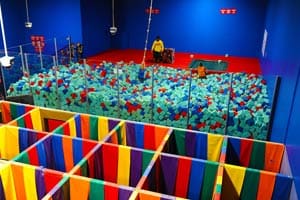
Trampoline parks are increasingly popular places for family recreation and children’s parties, but state and federal inspections and regulations for the facilities are lacking, putting jumpers at risk for injury. Television station 13News Now (in Chesapeake, Virginia) investigated injuries at two local trampoline parks. The station tracked 911 calls for ambulances from Cloud9 and Rebounderz […]

Trampoline Parks: Jumpers Risk Injury
Trampoline parks are increasingly popular places for family recreation and children’s parties, but state and federal inspections and regulations for the facilities are lacking, putting jumpers at risk for injury.
Television station 13News Now (in Chesapeake, Virginia) investigated injuries at two local trampoline parks. The station tracked 911 calls for ambulances from Cloud9 and Rebounderz trampoline parks. The station said it has “counted dozens of ambulance trips to Cloud9 in just the last year.” In Newport News, emergency services tracked eight trips to Rebounderz.Dr. Todd Parker at the Chesapeake Regional Medical Center said he sees many injuries from the trampoline park in the hospital’s emergency room. Ankle sprains are probably the most common injuries he said, but there are also broken bones, including spine and neck fractures.
Trampoline park operators defend the safety of their facilities with charts showing a relatively low rate of injury for trampoline jumping compared to such activities as soccer, baseball, and football. But the data they provided is from 2002 and is now more than 13 years old, 13News Now reports. The American Academy of Pediatrics released a report in 2012, which says the data about trampoline park injuries is insufficient to draw any conclusions on safety.
The International Association of Trampoline Parks has created safety standards that deal with such matters as the thickness of foam padding and the training of court monitors. But 13News Now notes that these standards are voluntary and the parks’ operations are not regulated by the government.
Rebounderz told 13News Now that it provides employee training, safety videos for guests and continually improves its policies and operations for the “safest possible guest experience.” According to the facility’s public relations firm, Rebounderz follows voluntary safety standards in the ratio of court monitors to people jumping. For every 32 jumpers, there is one monitor keeping watch. In answering questions from 13News Now, the park said guests are shown safety videos “prior to jumping every time they visit,” and a safety video plays continuously on several screens in the arena. When a jumper violates a safety rule, a referee coaches the user to ensure they understand the safety rules. Referees in the jumping area are not allowed to use cell phones during their shifts. Head-first dives and wall flipping, two dangerous activities, are never allowed, the facility said
Most trampoline parks require patrons to sign a liability waiver to use any of the equipment and sometimes even to enter the trampoline area. The user acknowledges the risks of this activity and says the park is not responsible for injuries. The waiver also limits the right to sue.


